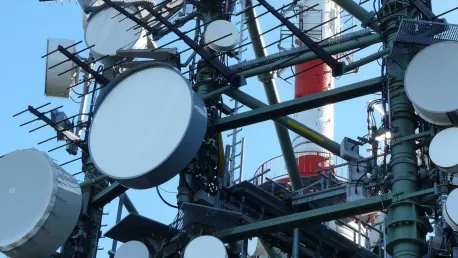In a transformative bid to bridge the longstanding digital divide exacerbating social and economic disparities, the U.S. government has embarked on a groundbreaking initiative to promote broadband access in remote areas through an unprecedented $42.35 billion federal program. This ambitious project seeks to ensure that every American home and business can benefit from high-speed internet, a necessity that has become increasingly apparent in the wake of the COVID-19 pandemic. The program is particularly focused on utilizing satellite technology to overcome the challenges posed by providing connectivity in regions where traditional fiber optic cables are not cost-effective due to difficult terrain and extensive distance.
In states like Pennsylvania, which boasts over 15,000 remote sites, the logistical and financial hurdles of deploying fiber-optic solutions are particularly acute. Thus, the state exemplifies the broader challenge faced across rural America. The Pennsylvania Broadband Development Authority has highlighted the critical need for alternative technological solutions, such as using smartphones that connect to satellites to avoid the problem of dead zones prevalent in these areas. However, experts like Sascha Meinrath from Penn State University caution that while satellite broadband is an essential stopgap solution, it comes with its own set of challenges, notably higher costs and latency issues stemming from the significant distances satellites maintain from the Earth’s surface.
Diverse Technological Solutions for Rural Connectivity
The federal program’s allocation strategy ensures that resources are distributed to individual states to address their unique connectivity challenges. Pennsylvania, for example, has been earmarked $1.16 billion for its efforts to enhance broadband access. While the preference is for fiber optic connections due to their superior reliability and lower latency, the funding permits the exploration of alternative technologies like satellite phones and fixed wireless signals in scenarios where the costs of fiber deployment are prohibitively high.
Prominent companies in the satellite internet sector, such as Hughes Network Systems and Viasat, play a vital role in this modernization effort. Additionally, T-Mobile’s Starlink initiative, spearheaded by Elon Musk’s SpaceX, has garnered attention for its innovative approach to satellite telephone service. By deploying a constellation of low-Earth orbit satellites, Starlink aims to provide more extensive coverage, particularly targeting regions that have traditionally been left out of the high-speed internet revolution due to their distance from traditional cellular towers.
The push to enhance broadband coverage through satellite technology signifies a significant shift in the approach to addressing rural communication needs. Even though satellite internet is not without its drawbacks, such as occasional latency and varying speeds, its ability to reach isolated and underserved locations promises to make a meaningful impact. By embracing a multi-faceted strategy that leverages both terrestrial and extraterrestrial solutions, the program aspires to furnish equitable internet access, thus fostering economic opportunities and improving quality of life for millions of Americans living in remote areas.
Balancing Practicality and Economic Viability
As communities and authorities grapple with the intricacies of implementing this sweeping broadband initiative, ongoing debates continue about the optimal methods for providing reliable internet service. For instance, in Washington County, authorities have predominantly opted for fiber-optic broadband but acknowledge that satellite technology might be indispensable for achieving 100 percent coverage. Conversely, neighboring Westmoreland County strongly favors wired fiber solutions, recognizing the potential hurdles of deploying satellite technology in specific cases but remaining steadfast in their commitment to traditional methods.
Public feedback has been an instrumental component of refining these broadband strategies. Dave Tyler, a vocal advocate for exploring cost-effective solutions, suggested the broader adoption of Starlink’s services to mitigate expenses. Such community input underscores a broader consensus on the importance of considering all viable options to achieve the overarching goal of nationwide, high-speed internet access. By engaging stakeholders from multiple sectors, the program endeavors to tailor solutions that are both technologically sound and economically sustainable.
Despite the pressing urgency to connect remote areas, there remains a delicate balance to strike between affordability, reliability, and the quality of service. Given the different geographic and demographic contexts across the United States, there is no one-size-fits-all solution; instead, a nuanced approach is necessary to address region-specific requirements. The federal government’s substantial financial backing helps pave the way for innovative solutions to flourish, promoting cooperation among private companies, state authorities, and local communities.
Looking Forward: Bridging the Digital Divide
The U.S. government has launched a transformative initiative aimed at reducing the digital divide that deepens social and economic inequalities. This groundbreaking $42.35 billion federal program is designed to boost broadband access in remote areas, ensuring every American home and business can enjoy high-speed internet. The necessity of such access became especially clear during the COVID-19 pandemic. By leveraging satellite technology, the program seeks to address the difficulties and high costs associated with deploying traditional fiber optic cables in rugged and distant locations.
Pennsylvania, with over 15,000 remote sites, exemplifies the complex logistical and financial challenges of fiber-optic deployment in rural areas. The Pennsylvania Broadband Development Authority has emphasized the critical need for alternative technologies, like smartphones that connect to satellites, to mitigate dead zones. However, experts like Sascha Meinrath from Penn State University point out that while satellite broadband serves as a crucial interim solution, it presents challenges, including higher costs and latency issues due to the distance satellites maintain from Earth.









